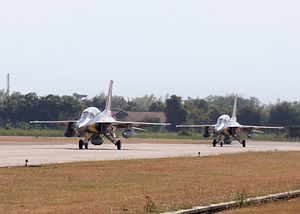Last week, Indonesia inaugurated two new air force squadrons. While the development had been expected and flagged by Indonesian officials ahead of time, it nonetheless highlighted the ongoing efforts by the Southeast Asian state to further develop and modernize its military.
As I have noted before in these pages, Indonesia has continued to advance efforts to develop its military into what has been termed a Minimum Essential Force (MEF) by 2024 under President Joko “Jokowi” Widodo, which includes building up its air force capabilities. Last year, Indonesia’s Air Force Chief Yuyu Sutisna had articulated an ambitious goal that was widely reported where Indonesia would plan on having eight squadrons of fighter jets by 2024, with each of them having 16 fighter jets, along with six squadrons of light, medium and heavy duty transport planes, with each of them having 16 aircraft to help with supporting troop mobility and logistics.
Last week, Indonesia’s air force development was in the headlines again with the inauguration of two new air force squadrons. The inauguration of the new squadrons took place on June 14, in a ceremony attended by top Indonesian military officials.
The two new squadrons were the Aviation Squadron 33 at Sultan Hasnuddin Airbase in South Sulawesi, and the Aviation Squadron 27 at Manahua Airbase near West Papua. Both squadrons are intended to help with a range of tasks including transport assistance to support disaster management, humanitarian assistance, and medical evacuation.
In terms of equipment, Aviation Squadron 33 is expected to consist of of several Hercules planes and personnel, and the Aviation Squadron 27 consists of CN-235 aircraft. Both squadrons are also expected to see additions as well, be it through transfers from other units or new deliveries of aircraft that are expected over the next few years.
According to official statements issued by the Indonesian Air Force, in remarks given following the inauguration of the two squadrons, Indonesia’s air force chief Yuyu Sutisna said that the new squadrons would be an important part of an effort by the TNI-AU to strengthen and promote interoperability between various military units throughout Indonesia. He also acknowledged candidly that there were limitations with respect to equipment and personnel that were in play with both of these units, in spite of what was expected of these squadrons.
Sutisna’s comments are testament to the fact that Indonesian officials are well aware that in spite of these new squadrons, Indonesia is still far from realizing the ambitious targets that it has officially set out. Though Jakarta continues to make dents in achieving its goal of a modernized military, there still remains a long way to go.

































